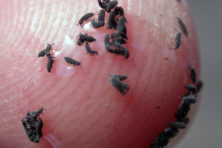Door to Nature: Snow Buntings
- Share
- Tweet
- Pin
- Share

It was on my drive to a morning meeting that I saw a flock of about 300 snow buntings flying and landing, and doing that over and over on an open field of harvested grain. I stayed in my car along the side of the road and watched them with great joy. This was the largest flock that I had seen in more than 10 years.
Our Christmas bird counts of the Sturgeon Bay area had snow buntings recorded in 15 of the 23 years, and they were seen during the count week in three other years. The Brussels count in Southern Door had them in 17 of the 22 counts. The greatest numbers were seen in 2005, with Sturgeon Bay counting 429 and Brussels seeing 573.
Snow buntings are circumpolar, meaning that they nest in all parts of the far north around the globe. They are the farthest-north-nesting small songbird and breed within the Arctic Circle. The nest is built using very curly, short grass mixed with moss: a substantial structure with walls an inch or more thick and a small, deep cavity to protect the eggs and hatchlings from the severe cold and winds in that part of the world.
The breeding grounds are near the Arctic Ocean, so it’s easy for the female to find waterfowl feathers and down to line the nest cavity. Molted feathers of ptarmigan are routinely used by buntings, redpolls and some longspurs. The nest is often placed so it’s hidden by tussocks of grass or partly under a rock.
Clutch sizes range from four to nine eggs, with the larger number laid in the northern part of the bunting’s range. Perhaps the survival rate is lower in the northernmost areas. The male sings to the female all the while she incubates the eggs. He begins his song by rising high up in the air, and, at the end of the strain, drops suddenly to the ground. He helps to feed the young and his mate by taking beetles and other insects to the nest.
Insects are the only things fed to the young. Adult buntings eat flies, mosquitoes, moths, weed seeds and the minute shellfish that attach themselves to the leaves of water plants and rushes. That helps to make the bird plump, which is important to its survival in its harsh environments. It has to acquire an extraordinary power to resist the cold, or it wouldn’t survive near the North Pole.
In winter, the snow buntings move south into central Europe, northern China and the northern tier of the United States. These southward invasions are always uncertain and irregular in all sections of their habitat. In years of heavy snow, they’ve been seen as far south as the Ohio River, northern Georgia, northern New Mexico and northern California.
Few birds have more appropriate and descriptive names than the snow bunting, which is sometimes called the white snowbird or snowflake. It thrives in heavy snows and biting winds. Its summer plumage is blacker on the back, but in the winter, the feathers tend to be a soft brown, with just some black in the wings.
The snow bunting is stout, compactly built with short legs, and is about seven inches long – just a little bigger than the familiar house sparrow. It can blend in with a snow-covered field because there is so much white in its plumage. The underside is all white, and there is much white on the head, neck, tail and wings. Buntings are grouped in the same family with finches, grosbeaks and sparrows.
You can drive past an open field with all the snow buntings feeding on the ground and completely miss them. However, they frequently fly up in unison and swirl around as a tight-knit group and then drop down to the ground again. That’s the excitement of seeing these huge flocks: They frequently surprise you when you least expect to see them.
Winter flocks can often include some Lapland longspurs and horned larks. Depending on the harshness of our winter, by late February the snow buntings will slowly drift back north to the longer Arctic days. We will have enjoyed them briefly as our “snowbirds” if we’re lucky enough to sit in a car on a back country road and thrill at their flashy, sweeping flights of black and white.




